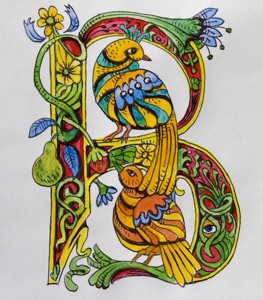Glossary
of Pysanka-Related Terms
Glossary
of Pysanka-Related Terms

B
barylka (барилка): literally “small barrel,” this is the name of one of the traditional pysanka divisions. A pysanka with a barylka division has one large band of design around its middle, and often has two or more secondary bands.
batik: another name for wax resist dyeing.
Berehynia (Берегиня): The Ukrainian version of the great goddess. She is often depicted on Ukrainian folk pysanky in highly abstracted/stylized form. The berehynia is usually an upright figure with 2, 4 or 6 arms (a variation of the oranta).

besahy (бесаги): saddlebag, carrier bag. Worn around he shoulders or over the front of a horse. This term was used in Podillia to describe a hand of god/ram type symbol.
Besarabia: is a historical region in Eastern Europe, bounded by the Dnister river on the east and the Prut river on the west. The bulk of Bessarabia is currently part of Moldova, whereas the northernmost regions, as well as the southern regions bordering the Black Sea (Budiak), are part of Ukraine.
bezkonechnyk (безконечник): eternity band, never-ending line. A common motif on pysanky, and an ancient one. It is one of the symbols of the Zmiya (Serpent).
Bilous (Білоус): Oksana Bilous, a well-known pysankarka and author. She has written a Ukrainian language book on pysanka techniques («Мистецтво писанкарства»/The Art of Pysankarstvo), and co-authored «Школа Писанкарства» (School of Pysankarstvo, about pysankarstvo education) with Zoya Stashuk. She has also authored a small book about pysanka symbolism («Символічна мова писанок»/The Symbolic Language of Pysanky). In 2007 she released a DVD in which she creates a pysanka, step by step, and narrates the process, called «Всесвіт у моїх долонях» (the Universe in the Palms of my Hands”).
Binyashevsky (Біняшевський): Erast Binyashevsky, author of a Ukrainian book about traditional folk pysanky published in 1968. His plates have become widely republished and can often be seen on the internet without attribution.
biser (бісер): beads. The singular form is busyna (бусина).

Blas-fix: a German made tool used to empty and egg through a single hole. ІIt is a small plastic bellows connected to a curved tube. The Blas-Fix is no longer in production.
Boiko: alternative spelling of Boyko.
bokova ruzha (бокова ружа): a ruzha motif centered on the side of a pysanka.
Boyko (Бойко): a Ukrainian ethnographic group located in the Carpathian Mountains of Ukraine and Poland. The Boykos inhabit the central and the western half of the Carpathians in Ukraine across such regions as the southern Lviv Oblast (Skole, Turka, Drohobych, Sambir and Stary Sambir raions), western Ivano-Frankivsk Oblast (Dolyna and Rozhniativ raions) and parts of the northeastern Zakarpattia oblast (Mizhhiria Raion), as well as the adjacent areas of southeast Poland and northeast Slovakia.
To the south or southwest of Boykos live Lemkos, and to east or southeast are the Hutsuls, the two other highlander ethnicities of Ukraine. Author Ivan Franko was a Boyko.
Brazilwood: A natural dye produced from brazilwood trees that produces red, purple, and pink and coral tones.
Bukovyna: The territory between the middle Dnister River and the main range of the Carpathian Mountains, around the source of the Prut River and the upper Seret (Siret) River, the border area between Ukraine and Romania. Today Bukovyna is divided between Ukraine (incorporating Chernivtsi oblast or most of northern Bukovyna) and Romania (containing most of the Suceava region or southern Bukovyna).
Back to Glossary home page
Back to MAIN Pysanka home page.
Back to Pysanka Index.
Search my site with Google
